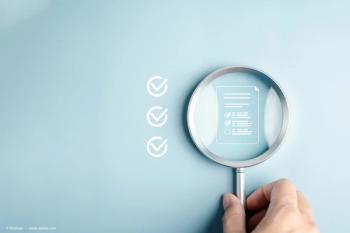
Rebound tonometry useful tool to measure IOP in children
Device is noninvasive, nonthreatening; does not require topical or general anesthesia
Rebound tonometry is a disruptive technology for checking IOP in children. It has tremendous penetration in pediatric ophthalmology practices around the world, notes Scott R. Lambert, MD. The device bounces a small, lightweight disposable probe off the cornea.
Measuring intraocular pressure in children is a challenge. So much of a challenge that many ophthalmologists do not bother in the absence of any signs or symptoms suggesting there may be a problem. A relatively new method of assessing IOP, rebound tonometry, can ease the burden.
“What used to happen is that intraocular pressure was rarely checked in young children because it is such a difficult thing to do,” said Scott R. Lambert, MD, professor of ophthalmology and pediatrics at Stanford University School of Medicine.
“When we absolutely had to check the intraocular pressure, in most cases we had to take them to the hospital and do it under general anesthesia.
“With rebound tonometry, we now check IOP on virtually every child that comes in for an exam, even if they don’t have a known problems with intraocular pressure when they come in,” he said. “Measuring IOP is such a simple thing to do with this technique.”
That was before pediatricians, ophthalmologists, anesthesiologists and the FDA recognized that repeated use of general anesthesia may affect the neurodevelopment of young children. And before Finnish medical device maker iCare developed the first rebound tonometer.
Unlike Goldman applanation, Kowa, Tono-pen and non-contact air puff devices, rebound tonometry is noninvasive, nonthreatening, does not require topical or general anesthesia and can be used at any age.
“I had a patient come in recently with glaucoma who was two weeks old and I could check the intraocular pressure in this child with rebound tonometry,” Dr. Lambert said.
“It has really changed how we manage these children.”
Technology assessment
Dr. Lambert is the chairman of the Pediatric Ophthalmology Technology Assessment committee of the American Academy of Ophthalmology that evaluated rebound tonometry.
The committee concluded that rebound tonometry is a useful screening tool. It is widely used by pediatric ophthalmologists in the U.S., he said, but not so widely by general ophthalmologists.
“It is a very important part of the equipment that you should have in your office,” he advised.
“Rebound tonometry is a disruptive technology for checking the intraocular pressure in children. It has tremendous penetration in pediatric ophthalmology practices around the world.”
The handheld battery-powered device bounces a small, lightweight disposable probe off the cornea, measuring the deceleration and rebound time to calculate IOP. Models are available for clinical use, home use, and veterinary use.
The device was approved for human use by the FDA in 2007. A technical review by NICE, the National Institute for Health and Clinical Excellence in the UK, found that iCare devices provided generally similar intraocular pressures compared to Goldman applanation measurements, although there was less agreement between the two methods at higher pressures.
Value as screening instrument
The AAO technology assessment group assessed the outcomes of four pediatric studies. The group found that rebound tonometry tended to measure 2–3 mm Hg higher than Goldman applanation tonometry. Differences between the two techniques were greater at higher pressures.
“Rebound tonometry is a great screening tool,” Dr. Lambert said.
“If you get a high pressure from rebound tonometry, you need to follow up with some other test. But if the pressure is normal, you can be pretty confident that the child’s IOP is okay and no other testing is needed. The group also noted that rebound tonometry is better tolerated than applanation tonometry in young children.
Cost is also considerably lower for rebound tonometry. Each rebound tonometry measurement costs a few dollars versus a few thousand dollars for each an exam-under-general anesthesia.
Ophthalmologists were reluctant to subject children to an exam-under-anesthesia unless an IOP reading was absolutely necessary even before the recognition that extended or repeated general anesthesia may affect the developing brain.
Hospitalization was traumatizing to child and family as well as expensive. As a result, a small subset of children with known glaucoma or other IOP abnormality were subjected to general anesthesia 20 to 30 times during childhood.
And most children never had their IOP measured. It has long been recognized that many children will develop glaucoma following cataract surgery, Dr. Lambert noted, but the pathogenesis of glaucoma in this population has been largely unknown because IOP was rarely measured after pediatric glaucoma surgery.
“In many cases, glaucoma following congenital cataract surgery was reported to develop at older ages,” he explained, “but I think that was because they just didn’t have the ability to check IOP easily and regularly while they were young.
Rebound tonometry is giving us more information about the natural history of glaucoma following pediatric cataract surgery because we can now check IOP throughout childhood. It is helping us to understand the disease better and to treat at the most appropriate time rather than after they have more advanced disease.”
Disclosures:
Scott R. Lambert, MD
P: 650/725-5743
Dr. Lambert did not indicate any proprietary interest related to the subject matter.
Newsletter
Don’t miss out—get Ophthalmology Times updates on the latest clinical advancements and expert interviews, straight to your inbox.



















































.png)


